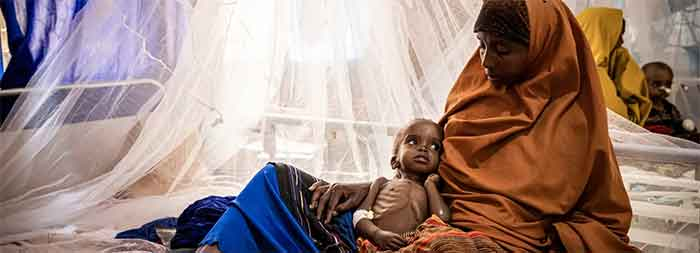2011-12 was a very sad year for Somalia. As hunger related to drought and other factors was worsening, a famine situation was not declared officially till very late and relief supplies were delayed. The result was that a large number of people perished in famine deaths even before famine was officially declared. A total of as many as 260,000 people died in this famine. Nearly one half of them were children below five years of age.
It is feared that this year there can be a drift towards a somewhat similar tragedy. There have been five seasons of drought or below average rain, and this may get extended. The Al-Shabaab militants hold sway over significant areas, making it difficult for relief supplies to reach there. The sanctions imposed as a part of counter-terrorism drives of the USA also make it difficult for relief organizations to operate from these and nearby areas.
Ethiopia is another country of the Horn of Africa region which has experienced mass famine deaths in the past. Nearly a million people are reported to have perished here during the famine of 1983-85, according to UN data. Apart from prolonged drought, conflict is a major factor responsible for accentuating distress here too, even though the situation here has eased somewhat following an agreement reached by the Federal government with Tigray rebel groups.
Prolonged drought has also affected more limited parts of Kenya. Although the Horn of Africa drought is often discussed in terms of these three countries, some studies and reports include other neighboring countries as well. The situation concerning widespread hunger is also serious in some of these other countries including South Sudan and Sudan in particular.
While warnings about the possibility of famine deaths have been voiced since about a year now, famine has not been declared officially yet but it is highly probable that famine will be declared in 2023. During the last year the situation here has worsened due to the Ukraine conflict as food and fertilizer supplies were adversely affected. Earlier there were COVID related difficulties. The WHO had also characterized this region as a region of a health emergency.
In such difficult situations, support for essential relief work has fallen short of real needs in most affected areas, to the extent that some feeding programs had to be cut, a situation that has been described as cutting off food to the hungry to spare something for the starving. What the western richest countries have spared for the various drought and hunger affected parts of the Horn of Africa region is less than 5% of what they have hastily assembled for Ukraine, once again drawing attention to the narrowly motivated nature of aid mobilization, leading to relative neglect of those in greatest need.
Clearly the Horn of Africa region is passing through one of its most difficult times and a much bigger relief effort is needed, requiring much more generous fund support which should not be delayed any further. While all the developed, OECD countries should contribute much more immediately, various emerging economies, particularly food surplus countries should also contribute without losing any further time. India should also extend more help. A significant number of people of Indian origin live in Kenya and the Indian government can provide relief supplies in the proper distribution of which this community too can help.

